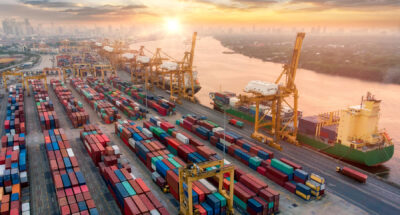
Building systemic resilience in supply chains
Turbulent times can leave businesses scrambling for measures to help them bounce back after disruption. But these actions may in fact increase overall supply chain fragility. ...

by Carlos Cordon Published 21 April 2022 in Supply chain • 6 min read
Companies all over the world have faced disruption in their supply chains because of the war in Ukraine and the shipping bottlenecks that followed in the wake of the COVID-19 pandemic. Car production lines have stalled because of the shortage of wire harnesses, farmers cannot find enough fertilizer and animal feed, chip makers are short of neon, a critical gas.
These problems have accelerated a rethink in global sourcing. The past three decades have marked an era of hyper globalization as companies have prioritized cheap offshore production in low-wage locations such as China, keeping the cost of consumer durables low and turning global trade into a deflationary force.
But the conflict in Ukraine has reinforced the importance of building more resilience into supply chains. The pandemic has already exposed the risks of offshoring, as supply has not been able to keep pace with heightened demand as economies have recovered, with the shortage of semiconductors among the major problems.
Many companies are now looking at bringing production closer to home to improve the availability and security of supply, in what could be a substantial reshaping of global value chains. “The Russian invasion of Ukraine has put an end to the globalization we have experienced over the last three decades,” BlackRock chief executive Larry Fink wrote in his recent annual letter to shareholders. He may be right.
Governments are trying to boost their domestic industries and reduce the risks of being dependent on foreign nations by onshoring manufacturing. The war in Ukraine has only served to underscore the importance of supply chain sovereignty and domestic production.

Already well documented is Europe’s overreliance on natural gas and crude oil from Russia. Prices for gas have surged to record highs in recent weeks, causing a sharp rise in costs for European industry and inflicting severe pain on energy-intensive sectors from steel and aluminium to fertilizers and transport. This has increased pressure on companies to accelerate investments in renewable energy.
Another vulnerability is a dependence on Russia and Ukraine for key agricultural commodities. The two countries are the leading grain and sunflower oil suppliers to world markets, accounting for a 10th of wheat exports, 13% of corn and more than half of sunflower oil, according to UN Comtrade. Russia is also a key exporter of fertilizer and animal feed. The war is causing significant disruption to agricultural supply chains, threatening supplies and forcing sharply higher food prices.
Furthermore, Russia is a significant source of critical minerals, accounting for 30% of the world’s supply of palladium, 13% of titanium and 11% of nickel, as well as a major supplier of neon used for components in semiconductors. The soaring prices of minerals have forced big carmakers to cut vehicle sales forecasts.
The Ukraine conflict is part of a succession of supply shocks that are becoming more frequent and severe. The erosion of labor cost arbitrage because of rising wages, and soaring shipping costs and bottlenecks at ports, as well as heightened geopolitical risk from vaccine nationalism, Brexit and US-China tensions had already made some companies revamp their existing supply chain policies. There is also growing pressure on companies to reduce their carbon footprint.
Supply chain managers have been left reeling. Companies are developing multi-source procurement strategies, putting in place at least two suppliers in different locations that serve factories around the world, acting as a buffer against future supply disruption.
In addition, they are increasing the inventory they keep on hand and negotiating longer-term contracts with multiple suppliers in a significant shift away from the once dominant “just in time” supply chain strategy that lowered costs by keeping stock to a minimum.
Russia is a significant source of critical minerals, accounting for 30% of the world’s supply of palladium, 13% of titanium and 11% of nickel, as well as a major supplier of neon used for components in semiconductors.
But the most significant shift concerns globalization, which may well have peaked or could even enter a reversal. For supply chain executives seeking greater security of supply while geopolitical tensions flair, it’s not an issue of finding alternative suppliers; it’s re-thinking long-term where the supply chain will be.
Faced with long delivery times from Asia, some European companies have already relocated production nearer home such as Poland, Latvia and Lithuania, which have advantages such as cheap labor. But the conflict between Russia and Ukraine has made eastern Europe and the Baltics less appealing.
Manufacturing hubs in Southeast Asia could stand to benefit, along with the US and southern American nations such as Mexico and Brazil, in addition to southern European and north African countries such as Morocco and Turkey.
The global reordering of supply chains is a big opportunity for emerging markets. But there are concerns over the potential for social unrest and political instability because of food price inflation, which is heaping pressure onto poorer countries. The availability of labor is another major consideration for supply chain managers, because of low levels of unemployment.
Moreover, ideological divides, along with the rise of protectionism and nationalism, are increasingly hard for companies to navigate. The ability of multinationals to do business with countries that are seen to be supporting or ignoring Russian aggression in Ukraine will be tested. China, India and Pakistan were among those who abstained in UN votes condemning Russia’s assault.

Those who do business with these countries can expect to face much greater scrutiny. The US has already imposed export controls against Chinese technology company Huawei. In a similar vein, overseas companies have for years complained about the difficulty of manufacturing in China, with restrictions in sensitive industries, forced joint ventures and having to transfer proprietary technology into the country.
Companies will need to carefully reflect on their conditions for sourcing overseas, with many facing a sharp backlash for doing business with Russia. According to Dun & Bradstreet, there are 14,745 tier 1 (direct trading) and 7.6 million tier 2 (subcontract) supplier relationships with Russian companies globally.
Multinationals will need much greater visibility into the risks of tier 2 suppliers. The Ukraine conflict could herald a dramatic increase in vertical integration, when a company streamlines operations by taking direct ownership of the various stages of the production process.
As organizations take greater responsibility for every business in their value chain, far more resources are likely to be allocated to supply chain departments as they take on a greater strategic significance.
It could take months and substantial sums of money to move production to other locations, requiring factory space, machinery and tools, workers and financing. But with many companies pushing through steep price increases to cope with rampant inflation, these proceeds could be reinvested into near-shoring today for a more resilient, agile and responsive supply chain tomorrow.

Professor of Strategy and Supply Chain Management
Carlos Cordon is a Professor of Strategy and Supply Chain Management. Professor Cordon’s areas of interest are digital value chains, supply and demand chain management, digital lean, and process management.

25 July 2024 • by Amanda Williams, Gail Whiteman, Knut Haanaes in Supply chain
Turbulent times can leave businesses scrambling for measures to help them bounce back after disruption. But these actions may in fact increase overall supply chain fragility. ...

4 July 2024 • by Ralf W. Seifert, Philip Sieber-Gasser in Supply chain
The sheer complexity of trade regulation and the risk of non-compliance mean companies are missing out on billions in tariff savings from Free Trade Arrangements (FTA) in their global supply chains. New...

24 June 2024 • by Carlos Cordon in Supply chain
In an era of unpredictability, businesses must take many more strategic decisions about supply chain management, say IMD’s Carlos Cordon and supply chain adviser Tariq Farooq ...

13 June 2024 • by Suzanne de Treville in Supply chain
Many executives recognize the value of local manufacturing but struggle to shake off the view that low-cost production is better for the bottom line. Exploring their options through simulations and competitive games...
Explore first person business intelligence from top minds curated for a global executive audience